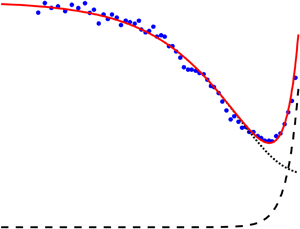Crossref Citations
This article has been cited by the following publications. This list is generated based on data provided by
Crossref.
Chen, Xin
2021.
Oscillatory velocity in boundary layer over mobile sediment bed under asymmetric wave and current conditions.
Journal of Hydrodynamics,
Vol. 33,
Issue. 6,
p.
1242.
He, Kang
Shi, Huabin
and
Yu, Xiping
2021.
An experimental study on aquatic collapses of bidisperse granular deposits.
Physics of Fluids,
Vol. 33,
Issue. 10,
Robinson, James A.
Holland, Daniel J.
and
Fullard, Luke
2022.
Granular packing in complex flow geometries.
Physical Review Fluids,
Vol. 7,
Issue. 7,
He, Kang
Shi, Huabin
and
Yu, Xiping
2022.
Effects of interstitial water on collapses of partially immersed granular columns.
Physics of Fluids,
Vol. 34,
Issue. 2,
Lee, Cheng-Hsien
Lo, Peter H.-Y.
Shi, Huabin
and
Huang, Zhenhua
2022.
Numerical Modeling of Generation of Landslide Tsunamis: A Review.
Journal of Earthquake and Tsunami,
Vol. 16,
Issue. 06,
Lee, Cheng-Hsien
and
Chen, Jia-You
2022.
Multiphase simulations and experiments of subaqueous granular collapse on an inclined plane in densely packed conditions: Effects of particle size and initial concentration.
Physical Review Fluids,
Vol. 7,
Issue. 4,
Zhao, Kai-Li
Qiu, Liu-Chao
and
Liu, Yi
2022.
Two-layer two-phase material point method simulation of granular landslides and generated tsunami waves.
Physics of Fluids,
Vol. 34,
Issue. 12,
Robinson, James A.
Holland, Daniel J.
and
Fullard, Luke
2023.
Complex behavior in compressible nonisochoric granular flows.
Physical Review Fluids,
Vol. 8,
Issue. 1,
Guan, Xiafei
and
Shi, Huabin
2023.
Translational momentum of deformable submarine landslides off a slope.
Journal of Fluid Mechanics,
Vol. 960,
Issue. ,
Fei, Jianbo
Shi, Huabin
Jie, Yuxin
and
Zhang, Bingyin
2023.
μ(J)-Rheology-based depth-averaged dynamic model for roll waves in granular–fluid avalanches.
Applied Mathematical Modelling,
Vol. 119,
Issue. ,
p.
763.
Jandaghian, Mojtaba
and
Shakibaeinia, Ahmad
2023.
A consistent multi-resolution particle method for fluid-driven granular dynamics.
Advances in Water Resources,
Vol. 178,
Issue. ,
p.
104488.
Xu, Tibing
Sun, Shuangke
and
Wu, Peng
2023.
Simulation of submerged granular flows by development of a two-phase incompressible explicit mesh-free method.
International Journal of Sediment Research,
Vol. 38,
Issue. 4,
p.
530.
Montellà, E.P.
Chauchat, J.
Bonamy, C.
Weij, D.
Keetels, G.H.
and
Hsu, T.J.
2023.
Numerical investigation of mode failures in submerged granular columns.
Flow,
Vol. 3,
Issue. ,
Zhou, Ye
He, Kang
Shi, Huabin
and
Yu, Xiping
2024.
Experimental study on collapse of partially submerged bidisperse granular columns.
Acta Mechanica,
Vol. 235,
Issue. 4,
p.
2041.
Guan, Xiafei
Hu, Kailun
Chen, Xin
Gao, Junliang
and
Shi, Huabin
2024.
Investigating the Intense Sediment Load by Dam‐Break Floods Using a Meshless Two‐Phase Mathematical Model.
Water Resources Research,
Vol. 60,
Issue. 7,
Li, Wenxin
Shi, Huabin
and
Yu, Xiping
2024.
A DEM-based Euler–Lagrange model for motion of particle–fluid two-phase mixtures.
Acta Geotechnica,
Vol. 19,
Issue. 2,
p.
971.
Fei, Jianbo
Liu, Zhihao
Khalid, Muhammad Irslan
Jie, Yuxin
and
Chen, Xiangsheng
2024.
Frictional-dilatancy effect in the description of immersed granular motion.
Powder Technology,
Vol. 431,
Issue. ,
p.
119086.
Li, Shuo
Li, Wenxin
Shi, Huabin
and
Guan, Xiafei
2024.
Hydrodynamics and Sediment Transport Under Solitary Waves in the Swash Zone.
Journal of Marine Science and Engineering,
Vol. 12,
Issue. 9,
p.
1686.
Zhang, Ri
Wang, Yumiao
Liu, Lei
Guo, Xiaoqi
Liu, Yong
and
Liu, Haixiao
2024.
One-dimensional model for vertical hydraulic transport of high-concentration mineral particles.
Physics of Fluids,
Vol. 36,
Issue. 10,
Guan, Xiafei
Wang, Xiekang
and
Shi, Huabin
2025.
Numerical investigation of submerged landslide impact on underwater blocks using a two-phase SPH model: Insights into re-acceleration and extra translational extension of slides.
Computers and Geotechnics,
Vol. 180,
Issue. ,
p.
107094.




